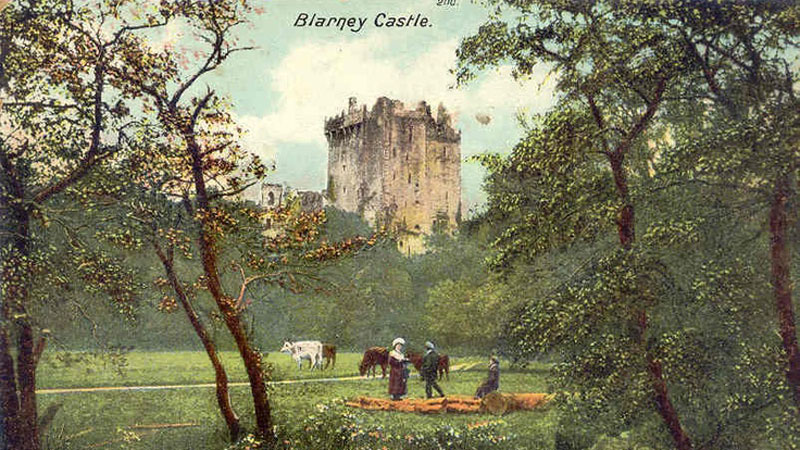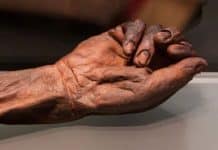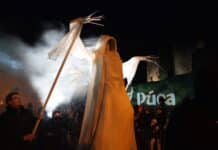Cork is the largest county in Ireland and is known as ‘The Rebel County’. With its coastline stretching along the Atlantic Ocean it has been the gateway to Ireland for centuries. The location of many battles, historical atrocities and the last place the Titanic set anchor, of course Cork is full of scary, sinister and spooky tales across the County! ANN MASSEY tells us 20 spooky things you didn’t know about Haunted Cork!

Here are the haunted Cork fun facts
- Still a working hospital, St. Finbarr’s started as the Cork Union Workhouse and was pushed to bursting with over 2000 inhabitants during the Great Famine in the mid-nineteenth century. It became the Cork Fever Hospital with patients dying in the hundreds weekly. Their disease-ridden bodies were carted away via the passageways running beneath the buildings. The ghost of a nun walks the wards and corridors, trying to communicate with children.
- In 1986 a Grotto in the village of Inchigeela was deemed a Devil’s Shrine after a young girl claimed to see Satan as she prayed. Two local priests carried out an unauthorised exorcism on the location.
- H.M.S Lusitania sank after being torpedoed off the Irish Coast in 1915 and the bodies were brought to the port of Cobh. A mass funeral procession and burial of all the victims took place a short while later. That funeral continues to be heard approaching the cemetery today and the White Witch of Cobh has claimed to see the very same cortege.
- Ballivereen House in Rosscarbery was the site of weekly hangings by the owner Coppinger who executed anyone who irritated him. He died from a fit of rage after being refused permission to hang a servant on the Sabbath and still haunts the location.
- Eglinton Asylum, also known as Our Lady’s and St. Kevin’s was an overrun Gothic asylum for those deemed mentally insane. Conditions were so atrocious a report deemed it the ‘Chapter of Horrors’. Many patients drowned in the adjacent River Lee and the asylum is now abandoned. Known as the creepiest place in Haunted Cork, seasoned paranormal investigators cannot stay more than a couple of hours due to the oppressive nature of the building and the constant feeling of someone behind you.
- In 1878, off the coast of Ballycotton a mysterious island complete with trees and rocky outcrops was spotted and dozens of local fishermen took to their boats to investigate. As they approached, the island vanished right before their eyes.
- On Thursday, April 11th 1912, the RMS Titanic loomed over the Port of Queenstown, where it had docked to board more travellers and the mail. 123 Irish passengers boarded rowing boats to the cruise liner from the wooden pier that remains to this day. Titanic raised anchor for the final time and at 1.30pm headed west for New York, no idea of the horror that was to befall her four days later. Of the passengers who boarded in Queenstown, only 44 survived. In the heritage centre, poltergeist activity has been rife and on the pier the spirit of a young woman in a red cape has been seen floating through the gates, looking expectantly out to sea.
- In the town of Bandon there was a rock in the road known locally as ‘The Money Stone’ which was said to mark the location of hidden treasure. Many tried and failed to dig their way to riches as they were driven back by an unseen malevolent force.
- Charles Fort in Kinsale was a working barracks in the late 17th century. To this day it is haunted by the ghost of a distraught bride known as the Lady in White following her groom being shot dead by her father. The bereft father of the bride jumped over the parapet and the bride discovered her dead husband and dead father. Unable to bear the horror she leapt to her death and remains in the Fort.
- The Stone of Eloquence situated at the top of Blarney Castle is more commonly known as the Blarney Stone and is said to give the ‘Gift of the Gab.’ Stories of its origin range from being the pillow of Jacob from the Middle East to being gifted to the former owner of Blarney for the slaying of a witch.
- Situated on South Main Street in Haunted Cork City, the Rennie Mackintosh styled Oval Bar was built by the Beamish and Crawford Brewery in 1905. A diverse clientele saw all walks of life including soldiers fighting for Ireland’s Independence. Despite the best efforts of the British to burn the pub to the ground they failed. It remains in original condition and is frequented by the spirit of a worn and weary soldier in a tattered uniform.
- Drombeg Stone Circle has a large stone known as ‘The Druids’ Altar’. In the thirties, a psychic was horrified as she ‘saw’ children being sacrificed by Druid priests and believed the place was defended by ‘spirits of darkness.’
- Cork City Gaol is a Gothic Citadel created to house the male and female prisoners of Cork since 1824 until closure. Since it re-opened in 1993 there have been voices and the word ‘Daddy’ being heard through the Gaol. A lady in a green shawl has also been seen wandering past the cells. It was the location of the annual Irish Ghost Convention from 2001-2016.
- In the town of Clonakilty there is a tomb. It contains the bodies of two priests by the name of O’Sullivan who were uncle and nephew and both were murdered by British Agents. Their joint tomb was fractured and their bodies revealed so the atrocity would always be remembered. Any effort to reseal the tomb has failed.
- Spike Island off the coast of Cobh is a tourist attraction much the same as Alcatraz and is not without its own ghosts. A Spectre known as the White Woman haunts the island and the perimeter walls are guarded by a phantom soldier staring through black hollows where his eyes once were.
- Carrigaphooca Castle in Macroom has notorious supernatural links. A local by the name of Cormac was given the task of tracking down Irish rebels and was caught eating the flesh from one of his slain victims. He is damned to haunt the castle. He is accompanied by a Púca who tries to attack any visitors.
- There is a place in Bantry Bay called Hungry Hill. It refers to the curse of the Great Famine known as Fear Gortach. Unmarked graves of famine victims would grow only weak and feeble foliage known as the ‘Hungry Grass’. If you stand upon it your appetite will never be sated and you will wither and die.
- In 1730 the St. Legers were residents at Ballyvolane House near Fermoy. They kept their valuables in a chest in their bedroom and slept peacefully unaware that they were about to be murdered by the butler and maid of the house. The elderly couple were shot and stabbed through repeatedly with a sword before the servants buried the chest to reclaim later. It wasn’t long before suspicion fell upon the two and after a failed attempt to flee they were convicted. Timothy Croneen was hanged at Gallows Green, hung, drawn and quartered. Joan Condon was convicted of being a witch and taken to the shadow of Ballyvolane House where she was burned at the stake. The treasure chest was never located.
- Ballinacarriga Castle in West Cork has many interesting features including the grotesque of a Sheela na gig, a medieval carving of a naked woman believed to represent lust and corruption. There is a garderobe on the second floor which is said to be the home of a Púca or Pooka, a shape-shifting creature of the fairy realm who terrorises those in its path. The chute is known as Moll the Pooka’s Hole and those walking in the vicinity are said to come away with injuries such as twisted ankles.
- In the Hollywood Estate in Haunted Cork as recently as 2010 a young family contacted the local media for help as they were being terrorised in their home by an unseen entity. What began as minor annoyances such as missing items and strange sounds, soon took a nasty turn for the Burke family. Screams would be heard in the dead of night and the climax was young Kyle being levitated and thrown from his bed. Shaman Paul O’Halloran was called in and he detected hundreds of spirits trapped in the house, including children and famine victims.
Discover more about haunted places to visit in Cork here.







